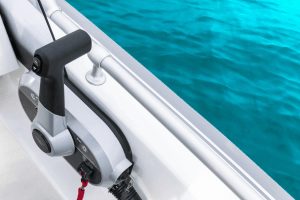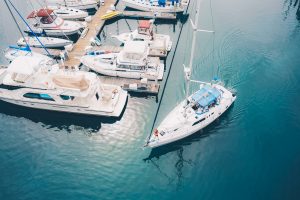
Have you ever been in the situation where you are about to enter a new marina and you suddenly feel paralyzed without having a clue of what you have to do to moor your boat safely and effectively?
Or what about when you are leaving your mooring space and suddenly the bow of your boat is blown by the wind, sending it crashing miserably into someone else’s anchor with the owner always there watching to put even more pressure on you?
Does all of this sound familiar?
You might have lots of skills and experience, but sometimes even the most seasoned sailor needs a bit of help in the form of extra mooring tuition. Would you like to have a method you can apply everywhere to dramatically increase your chances of success? If so keep reading to learn more about the 5 most useful tips suggested by an RYA Yachtmaster Instructor.

All boats react differently to the external forces involved:
– wind
– tide
You have to make good use of all the tools under your control:
– Engine gears: forward, reverse, neutral (yes neutral is a gear!)
– Engine power expressed in revs (revolutions per minute)
– Momentum (see displacement): how long does it take to stop your boat once you engage the “neutral gear”?
– Prop walk: where is your “propeller walk” kicking your stern, starboard or port?
– Steering wheel/rudder: hard over or 1/4 turn? Are you aware of the fact that the pivot point of the boat is different when you move forward or aft?
Some useful exercises you can do in open space:
– Keep a straight line reversing and follow a streamline of buoys or use a fixed object on the land (transit) behind your stern; try this with different speeds and wind positions in relation to the boat (on the bow, on the beam, etc.)
– Play with the throttle: forward or reverse at different speeds and neutral (see momentum)
– Make a 180-degree turn first with the help of the prop-walk and then a second time using the wind to make it push and turn your bow

One of the most neglected aspects of boat handling is preparation. During my time as an RYA Yachtmaster instructor, I’ve seen hundreds of boats coming into marinas who to seem to be leaving their chances of mooring successfully entirely in the hands of God!
They try to blindly navigate their way through this “unknown world” without a fender in sight or at best, placed at the wrong height, not to mention unusable mooring lines coiled like snakes around the backstays or the guardrails.
All the while “catatonic crews” are gazing blankly at the sky instead of listening to their skipper’s instructions. This is unfortunately, quite a common scenario everywhere I have been.
How do you avoid this happening? Study and plan! Nowadays there is no excuse for being unprepared because there is a mine of useful marina information available for free on the web.
Firstly, it is imperative to understand:
1) Marina layout:
– by consulting an updated pilot book or related web site
– by having a look at Google Maps satellite images, you can see the entrance and the pontoon layout; most of the time you can clearly see if there are finger pontoons or lazy lines, which makes a massive difference when you have to prepare your landing plan
Once you have a clear idea of the marina layout, you can:
2) Prepare the boat and the crew:
– Position the height of the fenders correctly, taking into account fingers, other boats and so on
– Arrange the mooring lines, remembering to pass the lines outside everything (this is very important!)
– Prepare a primary plan and a backup plan according to the wind (see section 3); debrief your crew adequately; clear and concise communication here is a must: use this simple template: NAME, ACTION, WHEN; e.g., “John, step off, now”
– Make a call on the Marina radio channel and:
– Ask permission to enter
– Ask for all the possible information regarding your assigned mooring
3) PLAN WITH THE WIND (first with TIDE if you are in tidal waters)
When you are out at sea, you may feel like the undisputed guru of the wind, you know perfectly how to trim your sails to move your jib car that centimeter forwards or backward; you instinctively feel any point of sail in your face, you know the slightest wind variation in angle and speed….and then as soon you fire up the cursed engine in the marina, you start acting like a beginner all over again and completely forget about your old friend the WIND!
A marina may be a more friendly human environment than the open sea, but you must always remember that the wind is still there, lying in wait for you!
You must always plan your mooring based on what the wind is doing, using the same scrupulous attention you had for your 25 days’ memorable Atlantic crossing to the Caribbean.
Is the wind on the beam reach?
How fast is it blowing?
Is the wind on your bow?
Can you then perhaps try to reverse all the way try to have it on the stern and as such have better control?
How much power do you need to keep the boat in a straight line to fight the wind force?
Are you aware of the wind at your berth?
Are you keeping an eye on other yachts’ Windex and flags closer to your berth?
Are you judging the wind speed properly?
Plan with the wind, and you are going to greatly increase your chances of mooring successfully!
4) PEOPLE

Forget about all the people milling around the marina starting from the “unskilled casual pontoon walker” to the “professional” marina staff!
It is hard to believe, but one of the most under-evaluated psychological aspects of successful mooring is the ‘performance anxiety’ pressure of having a captive audience scrutinizing your every move, making unwelcome suggestions or worse still, trying to intervene.
Don’t forget-not all these people are mooring experts, and none of them are mind readers!
They don’t know if the boat is holding the name of your ex-wife who is currently draining your bank account and in a moment of madness you have decided you want to deliberately smash the stern against the pontoon!
Nor do they know how your boat reacts under the engine, but most of all they don’t have the slightest idea about your plan and your crew arrangement.
It isn’t easy, but you need to pretend they are not there, they don’t exist, block out the excitable marina staff who always seem to have the wrong lazy line in their hand.
Do not let them inadvertently ruin your perfect plan; there is no room for politeness in the minefield that is mooring.
By not responding to them, you are letting them know that they are in the wrong position and doing the wrong thing!
As difficult as it is, you need to just ignore them and instead trust your crew and your plan.
5) EXECUTION aka PREPARE FOR THE WORST AND GET READY NOT TO “GUESS IT” BUT TO “IMPROVE, NOT IMPROVISE!
Now you have a perfect plan; the wind has been tamed, you know your boat’s reactions and your crew is correctly instructed and waiting in anticipation for a well-earned cold beer in the marina bar….. but then as soon you approach your berth you realize your maneuver is a total disaster!
Do not to try to fix the unfixable or improvise but instead, start from scratch, as soon you realise something has gone wrong. Go out and try again, do not be tempted to rectify the situation just because people are watching you, you are a hurry or God forbid, you want to show off!
Be modest, composed and patient, relax, take a deep breath and if it helps, do some short zen meditation, anything to keep you calm and focused.
Go out and try it again so you can avoid a last-minute emergency like people screeching from the other docked boat or your crew getting into a panic situation where they can severely injure themselves and risk losing a limb in order to save your boat.
By starting the maneuver from scratch, you have a chance to learn what went wrong and believe me, in my experience with my students, it is most likely you are going to be successful at maybe the 2nd or 3rd attempts, and what is more important is that you gain more and more confidence for the future.



